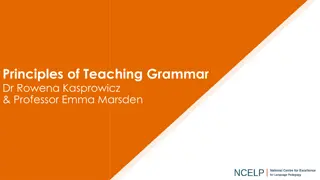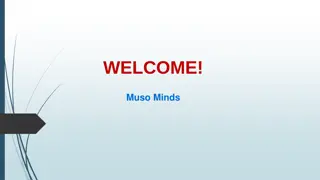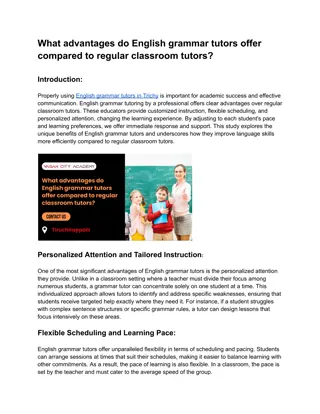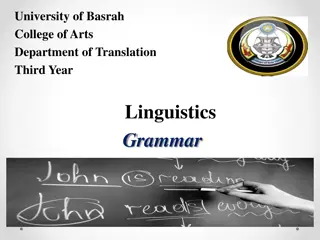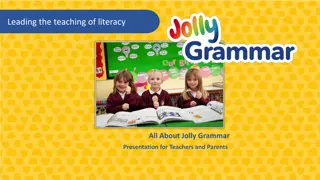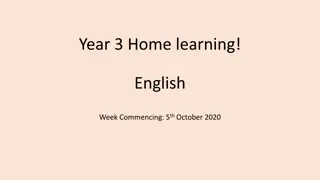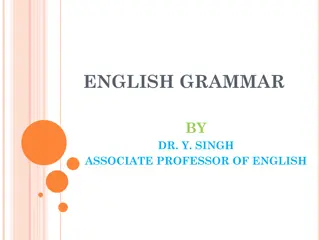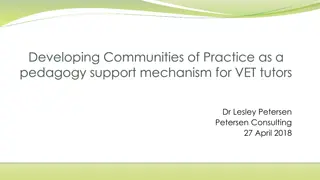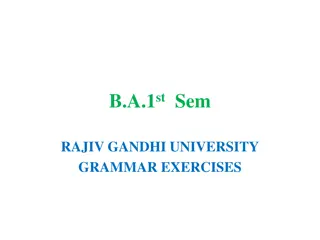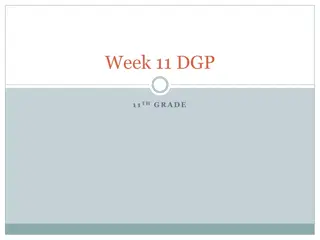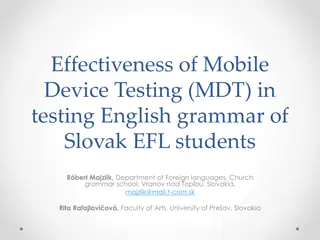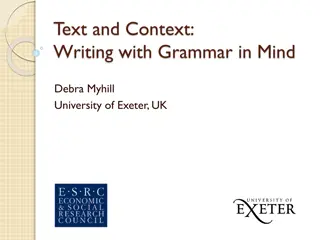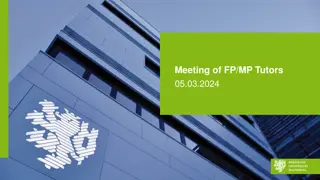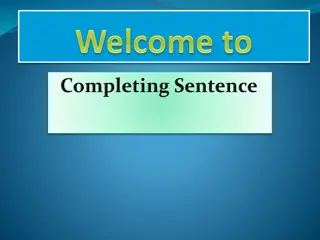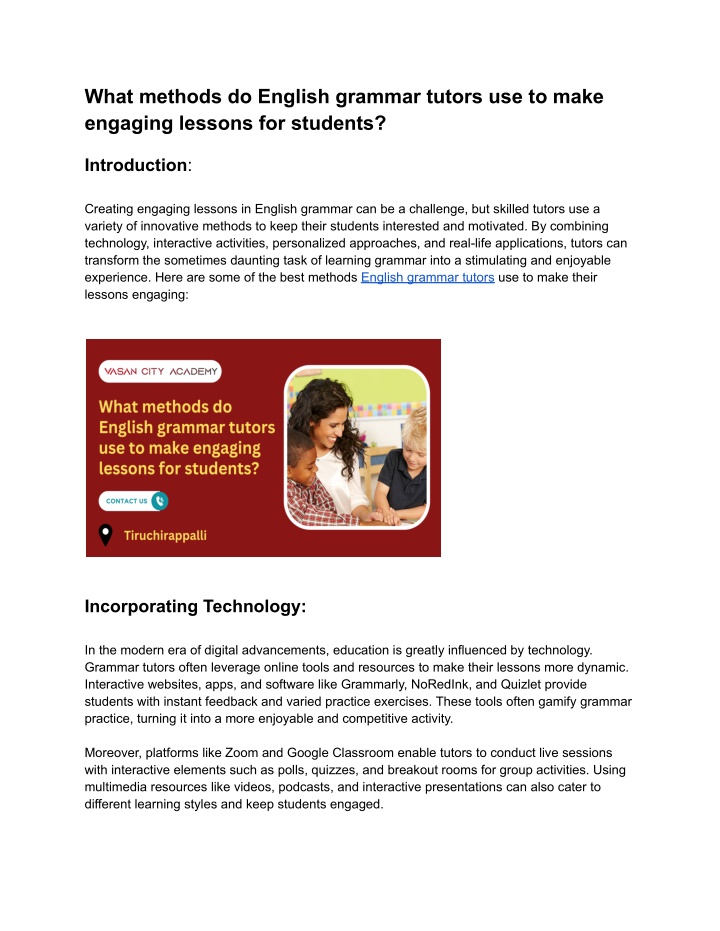
What methods do English grammar tutors use to make engaging lessons for students
Creating engaging lessons in English grammar can be a challenge, but skilled tutors use a variety of innovative methods to keep their students interested and motivated. By combining technology, interactive activities, personalized approaches, and rea
Download Presentation

Please find below an Image/Link to download the presentation.
The content on the website is provided AS IS for your information and personal use only. It may not be sold, licensed, or shared on other websites without obtaining consent from the author. If you encounter any issues during the download, it is possible that the publisher has removed the file from their server.
You are allowed to download the files provided on this website for personal or commercial use, subject to the condition that they are used lawfully. All files are the property of their respective owners.
The content on the website is provided AS IS for your information and personal use only. It may not be sold, licensed, or shared on other websites without obtaining consent from the author.
E N D
Presentation Transcript
What methods do English grammar tutors use to make engaging lessons for students? Introduction: Creating engaging lessons in English grammar can be a challenge, but skilled tutors use a variety of innovative methods to keep their students interested and motivated. By combining technology, interactive activities, personalized approaches, and real-life applications, tutors can transform the sometimes daunting task of learning grammar into a stimulating and enjoyable experience. Here are some of the best methods English grammar tutors use to make their lessons engaging: Incorporating Technology: In the modern era of digital advancements, education is greatly influenced by technology. Grammar tutors often leverage online tools and resources to make their lessons more dynamic. Interactive websites, apps, and software like Grammarly, NoRedInk, and Quizlet provide students with instant feedback and varied practice exercises. These tools often gamify grammar practice, turning it into a more enjoyable and competitive activity. Moreover, platforms like Zoom and Google Classroom enable tutors to conduct live sessions with interactive elements such as polls, quizzes, and breakout rooms for group activities. Using multimedia resources like videos, podcasts, and interactive presentations can also cater to different learning styles and keep students engaged.
Gamification: Gamification involves applying game-design elements to educational activities. Tutors might use grammar games, quizzes, and competitions to make learning more fun. For example, creating a grammar scavenger hunt where students find and correct errors in sentences or passages can be both educational and entertaining. Badges, points, and leaderboards can be integrated to motivate students and foster a sense of achievement and friendly competition. Another popular game-based learning tool is Kahoot!, where tutors can create custom quizzes that students answer in real-time, turning grammar practice into an exciting, interactive experience. Contextual Learning: Contextual learning helps students understand grammar rules by seeing how they apply them in real-life situations. Tutors can use examples from literature, news articles, and students' writing to illustrate grammatical concepts. This method not only makes grammar more relevant but also shows its practical application. Role-playing activities and simulations are also effective. For instance, students might role-play as journalists writing articles or characters in a story, using correct grammar in their writing and speech. This contextual approach makes grammar less abstract and more meaningful. Personalized Learning: Recognizing that each student has unique needs and learning styles, effective tutors tailor their lessons accordingly. They might conduct initial assessments to identify specific areas where a student struggles and then focus on those areas. Personalized learning plans can include custom exercises, one-on-one tutoring sessions, and targeted feedback. Tutors also encourage students to set personal learning goals and track their progress. This not only boosts motivation but also helps students take ownership of their learning. Interactive Activities: Engagement is often heightened through hands-on, interactive activities. Tutors can use manipulatives like sentence strips and word cards to help students physically build and deconstruct sentences. This tactile approach can be particularly beneficial for younger learners or those who struggle with abstract concepts. Group activities such as peer reviews and collaborative writing projects encourage students to learn from each other. Discussion and debate exercises can also improve grammatical skills, as students must articulate their thoughts clearly and correctly.
Storytelling and Creative Writing: Storytelling is a powerful educational tool. Tutors can use stories to teach grammar rules in context, making the learning process more engaging and memorable. Students might be asked to write their own stories, focusing on using specific grammatical structures correctly. Creative writing exercises, such as composing poems, short stories, or dialogues, allow students to practice grammar enjoyably and imaginatively. These activities not only reinforce grammatical concepts but also encourage students to express themselves and develop a love for writing. Using Real-World Materials: Real-world materials like newspapers, magazines, blogs, and social media posts provide authentic contexts for grammar practice. Tutors can use these materials to highlight correct and incorrect grammar usage, prompting students to analyze and discuss why certain rules apply. Analyzing real-world texts helps students see the relevance of grammar in everyday communication. It also exposes them to various writing styles and conventions, broadening their understanding and appreciation of the language. Incorporating Humor: Humor can be a great motivator and stress reliever in learning environments. Tutors might use funny sentences, jokes, and humorous examples to teach grammar rules. This approach can make lessons more enjoyable and memorable. Funny grammar videos and cartoons can also illustrate grammatical points in a light-hearted manner. When students are laughing and having fun, they are more likely to stay engaged and retain information. Flipped Classroom Model: In a flipped classroom, students learn new content at home through videos or readings and then apply that knowledge in class through interactive activities. This model allows tutors to spend more time on hands-on practice and personalized instruction. For grammar lessons, tutors might assign a video explaining a particular rule for homework. In the next class, students engage in activities that reinforce and apply that rule, such as writing exercises, games, or group work. This approach encourages active learning and ensures that class time is used effectively.
Regular Feedback and Positive Reinforcement: Timely feedback is crucial for student progress. Tutors provide constructive criticism and positive reinforcement to guide students toward improvement. Regular assessments and quizzes help track progress and identify areas needing further attention. Celebrating successes, no matter how small, can boost student confidence and motivation. Recognizing effort and progress, rather than just accuracy, encourages a growth mindset and a positive attitude toward learning grammar. Conclusion: Using gamification, contextual learning, personalized methods, interactive tasks, storytelling, real-life resources, humor, flipped classroom techniques, and consistent feedback, English grammar tutors can create engaging and effective lessons. These methods not only make grammar more interesting but also help students develop a deeper understanding and appreciation of the language. Through innovative and varied approaches, tutors can inspire their students to become confident and proficient in English grammar. For more information: Address: Vasan City, Tiruchirappalli, Tamil Nadu, 620102 Call us: +91 7010975193 Map Location: https://maps.app.goo.gl/rvyh3WQDPJE6D95Q9



